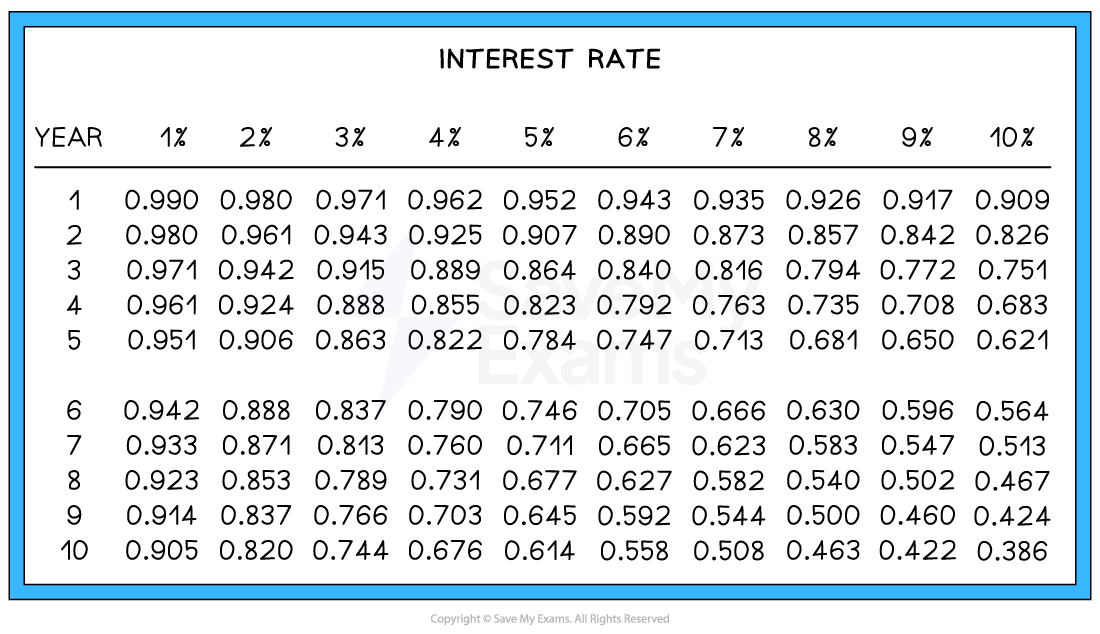Methods of Investment Appraisal (Cambridge (CIE) A Level Business): Revision Note
Exam code: 9609
The need for investment appraisal
Investment appraisal involves comparing the expected future cash flows of an investment with the initial expenditure on that investment
A business may want to analyse
How soon the investment will recoup the initial outlay
How profitable the investment will be
Before an investment can be appraised key data will need to be collected, including
Sales forecasts
Fixed and variable costs data
Pricing information
Borrowing costs
The collection and analysis of this data is likely to take some time
It requires significant experience to interpret the data appropriately before the investment appraisal can take place
Payback period
The payback period is a calculation of the amount of time it is expected an investment will take to pay for itself
The payback period is calculated using the formula
Worked Example
Gomez Carpets is considering an investment in a new storage facility at a cost of $200,000. It expects additional net cash flow of $30,000 per year as a result of the investment.
Calculate the payback period for the investment.
(3)
Step 1: Substitute the values into the formula
(1)
Step 2: Convert the outcome to years and months
(1)
Evaluating the use of the payback method
Advantages | Disadvantages |
|---|---|
|
|
Average rate of return
The average rate of return compares the average profit per year generated by an investment with the value of the initial capital cost
The average rate of return is calculated using the formula and is expressed as a percentage
This makes it easy to compare different investment options
Worked Example
Creative Frames, a small artwork framing business based in Bermuda, is considering an investment of $40,000 in new machinery. Megan, the business owner, believes that total returns over a 6-year period will be $76,000
Calculate the average rate of return of the proposed investment.
(4)
Step 1 - Deduct the capital cost from the total returns
(1)
Step 2 - Divide the outcome by the number of years of use
(1)
Step 3 - Substitute the values into the formula
(1)
Step 4 - Multiply the outcome by 100 to find the percentage
(1)
Evaluating the use of average rate of return
Advantages | Disadvantages |
|---|---|
|
|
The meaning of net present value
The net present value (NPV) takes into account the effects of interest rates and time
It recognises
The fact that that money received in the future is often worth less than money received today (inflation)
The opportunity cost of not having the money available for other uses
Calculation of net present value
To calculate the NPV of an investment, the value of all future net cash flows in today’s terms need to be calculated first and then discounted using a table
The cost of the initial investment is deducted from the total of the discounted net cash flows
If future net cash flows minus the initial investment are positive, then the investment is likely to be worthwhile
If the sum of future net cash flows minus the initial investment is negative, then the investment is unlikely to be worthwhile
Discounted cash flows are calculated using discount tables, which allow future cash flows to be expressed in today’s terms
Discount factors at different rates of interest

Worked Example
Brownsea Sightseeing Tours Ltd is considering purchasing a new pleasure craft at a cost of £325,000. It expects the investment to achieve the following net cash flows over five years of operation
Year | Net cash flow (£) | 10% discount factor (2dp) |
|---|---|---|
0 | (325,000) | 1.00 |
1 | 110,000 | 0.91 |
2 | 90,000 | 0.83 |
3 | 75,000 | 0.75 |
4 | 65,000 | 0.68 |
5 | 60,000 | 0.62 |
Using a 10% discount factor, calculate the NPV of the leisure craft investment.
(4 )
Step 1: Calculate the discounted cash flow for each year by multiplying the net cash flow by the discount factor

(3)
Step 2: Add together the discounted cash flow values for each year, including Year 0
(1)
The net present value of the investment is -£12,550
Interpretation of net present value
The outcome of the NPV calculation often determines the decision a business makes about an investment
Net present value outcomes
NPV result | Interpretation |
|---|---|
Positive |
|
Zero |
|
Negative |
|
However, care should be taken when assessing NPV outcomes
The discount rate matters
Choosing a higher rate makes future cash inflows seem smaller
NPV uses estimated figures
These forecasts may not be accurate
Case Study

SoluTech Energy is a medium-sized renewable energy company based in Indonesia. The business is focused on providing sustainable power solutions to rural communities and small businesses
The management team is considering a new investment: installing a set of high-efficiency solar panels at one of their key partner sites. The goal is to reduce long-term energy costs and demonstrate the company’s commitment to clean energy
The initial investment required is $50,000
After forecasting cash inflows and applying a suitable discount rate (to account for risk and time value of money), SoluTech estimates that the project will generate $60,000 in present value terms over the next few years
Net present value calculation
Business decision
Since the NPV is positive, SoluTech concludes that the investment will add value to the business
The project is expected to generate a return above its cost, so the company decides to go ahead with the investment

Unlock more, it's free!
Did this page help you?